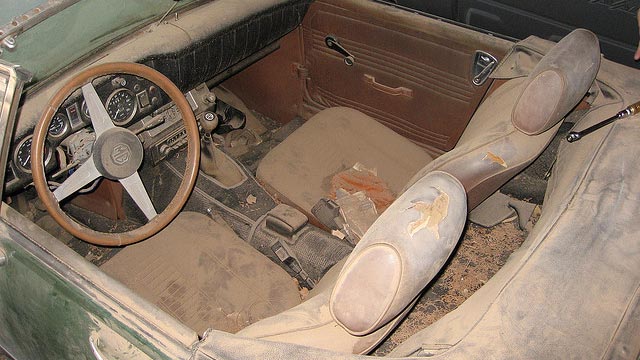7 Tips for Trade-Ins
Trading in your car is never going to get you as much as a private sale, but you can close the gap. Here's how.
So you want a new car but don’t want to deal with the hassle of selling your current one? It’s time to master the art of the trade-in.
It’s important that we just get one thing out of the way real fast – trading in a car will never yield the same price as selling it privately. Never. Ever. OK, now that’s out in the open let’s talk about some ways to close that value gap when trading in.
1. Clean it Up, But Don’t Go Crazy
Most websites, help columns and family members will tell you to make sure your car is spotless before you bring it in to discuss a trade. I can’t fully get on board with that, and there’s a couple reasons why:
When you sit down at a poker table you never want to tip your hand and that same rule applies to sitting a car salesman’s desk. Even if you are desperate to drop your crapmöbile, why would you want the dealer to know that?
And truthfully, most dealers really don’t care if your car is dirty or not. Chances are you’re trading in to a dealership with a service department that offers some sort of detailing work. What do you think happens when you sign on the dotted line? Your car gets a quick spa day before they slap on a sticker with a marked up price and roll it back onto the lot.
Even if you’re not trading it in to a fancy dealership, there’s usually a guy who works there named Gary that will clean it up. Gary’s not the best, but he knows how to Armor All a dash.
What You Should Do
This is not to say that you should leave gummy bears stuck to the seat or the dog’s nose prints on the windows. By all means, give the car a quick once over – wash, vacuum and pay particular attention to funky odors. That means those gym socks you’ve been scared of finally need to be removed from the trunk.

Just don’t go overboard by removing everything from the car. Don’t move the kid’s carseat and keep a few papers in the center console. You don’t want to make it look like you’re ready to make a clean break from the car (even if that’s exactly what you’re trying to do).
2. Take Care of the Little Problems
You know those problems that pop up with owning a car that you always say you’re going to get around to? Yeah, it’s time to get around to them. Here are some minor fixes that might have a dealer seeing green.
- Minor dents and scratches (damn you, shopping carts!)
- Foggy windows
- Curb rash on your wheels (happens to the best of us)
- Old tires

3. Understand the Market
There are a wealth of websites that will give you an estimated value for your car and one of the most popular is Kelly Blue Book. This goes without saying, but dealerships have the same access to these websites – and sometimes more – and assume you’ve already looked up your car’s value.
You absolutely should research your car’s value online and come up with a couple of prices before starting the trade-in process: the price you’d like to get for your car, and the price you’d be comfortable letting it go for.
Just remember to be honest about your car’s condition when doing research and remember that there are variables – such as your location and the time of year – that can play a role.
4. Shop Around
Take a look at a dealer’s used car inventory before going to talk trade. If the dealer already has similar inventory on their lot that’s been sitting there for a while, they may be less inclined to offer you a fair price.

5. Watch Your Language
“I need to trade in this car.”
“I need better gas mileage for work.”
“I need more room for my toddlers.”
Never let the dealer know you need anything. Except maybe a bathroom break during the negotiation … because, eww.
It may seem minor but dealership employees are trained to listen for hints of desperation. The more deperate you are, the less likely they are to give you the best deal possible.
Let the dealer sweat it out a little.
6. Be Realistic
Sorry to be a downer, but I have to state the obvious here: you will never get full value for your trade-in. If you want the most money, private sale is the only way to go. If you’re looking for the convenience of a trade-in, remember these points.
It’s a Business
A car dealership is not a charity – they need to make money on your trade-in to keep their doors open.** In other words, don’t expect market value for your trade-in.
“For a resale, the average dealer is looking to make between 2 (percent) and 4 percent on a transaction,” Painter says. “So take whatever your car’s value is and add in whatever cost it would take to refurbish the vehicle. Then, add in 2 (percent) to 4 percent, and as long as the trade-in price you’re given is in that window, it’s probably a fair deal.” From Bankrate
It’s a Game
On top of that, most dealers expect some negotiation so they’re going to come in low.
New Doesn’t Mean Better
If you’re looking to trade in a relatively new car, you’re going to have problems. The most depreciation for a new car happens when you drive it off the lot. That is money you are not going to get back.
7. Be Prepared to Walk Away
Dealers will always try to make it work. Whether they have to go “run this by their manager” or call you the next day with a “1-day only offer,” they want to close the sale and there are tricks they can use to make it happen.
- Dealers may give you more for trade, but only offer higher interest loans. To avoid this, use a loan from your local bank or credit union.
- If you’re upside down on your car (owe more than it’s worth) a dealer might offer to buy the car and tack on the negative equity to your new car loan. In this case, STOP. It might be time to reconsider a new car for now.
At the end of the day, you need to be prepared to walk away if the deal smells sour.
